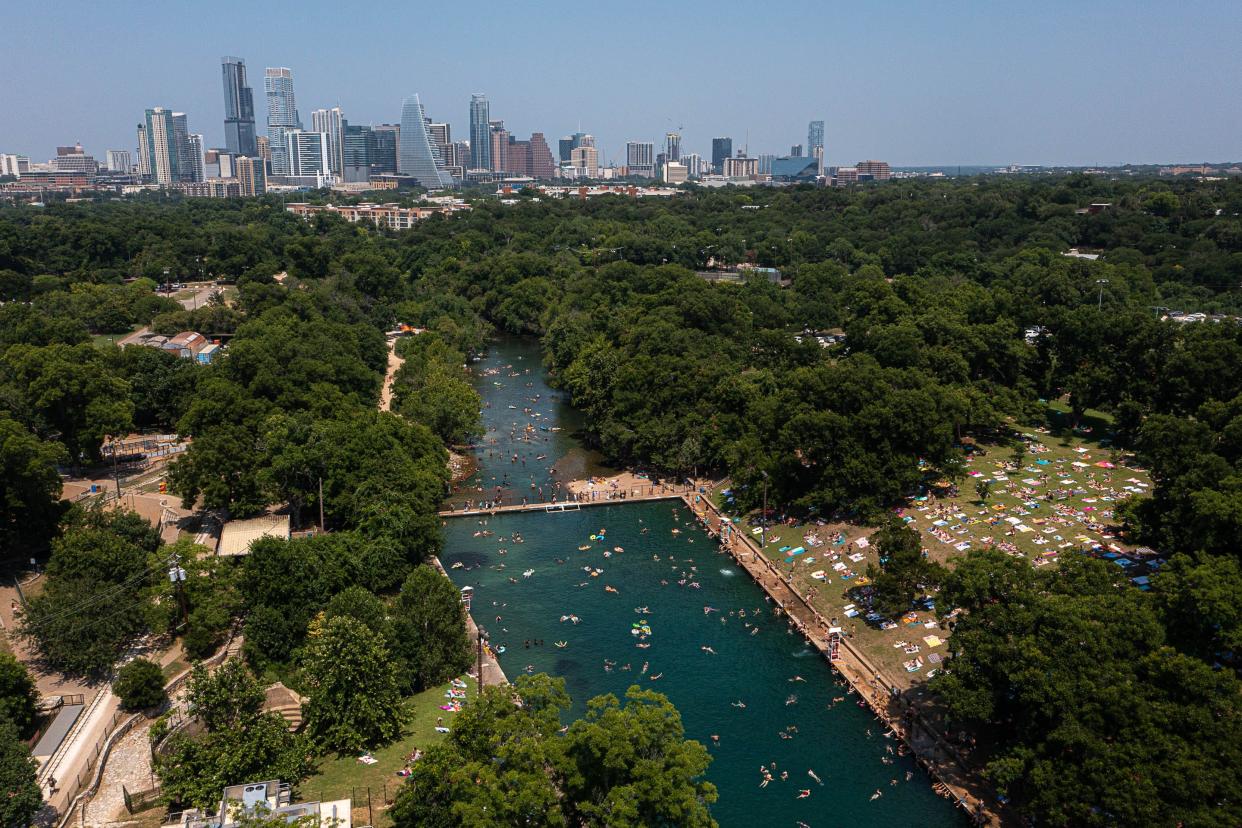It's scorching hot outside and there's 'no clear end in sight'

It's hot outside. Actually, that's an understatement. It's really hot outside, to the point that it's not safe to head outdoors without taking serious safety precautions to keep cool.
State infrastructure is also feeling the heat. The Electric Reliability Council of Texas, the agency that manages the state's power grid, on Tuesday asked people to voluntarily conserve energy due to "extreme heat and forecasted record demand." ERCOT made clear the grid was not in an emergency situation Tuesday.
Here's what we know about the latest forecast and extreme heat conditions in Austin:
More: As Texas swelters, ERCOT calls on residents to conserve energy amid record-demand
When will Austin's heat wave cool? 'No clear end in sight'
The National Weather Service extended its excessive heat warning through 9 p.m. Wednesday. Heat index values could reach anywhere from 105 to 118 degrees during this time, according to the weather service.
Temperatures were expected to reach 104 degrees Tuesday, with maximum heat index values at Camp Mabry forecast to hit a scorching 115 degrees Tuesday and Wednesday.
Since 1991, the normal temperature for June 20 in the Austin area is about 94 degrees, according to the weather service, or 10 degrees cooler than Austin's Tuesday and Wednesday forecast. The heat record for June 20 is 106 degrees, which Austin hit in 1925.
There’s a chance of “cooler” days ahead Thursday and Friday, albeit with temperatures that are expected to be above average. The weather service predicts that by the weekend the Austin heat wave will rally back into the triple digits and they will last through next week.
“No clear end in sight to this oppressive heat,” the weather service tweeted. “Continue to do what you can to keep cool!”
Although we'll get a couple of "cooler" days Thursday and Friday (still warmer than average), we anticipate this long-duration heat wave will re-strengthen over the weekend into next week. No clear end in sight to this oppressive heat. Continue to do what you can to keep cool! pic.twitter.com/HKMgvn1pxN
— NWS Austin/San Antonio (@NWSSanAntonio) June 20, 2023
Heat-related illness calls on the rise
Austin-Travis County EMS first responders have been called to several heat-related calls since temperatures began climbing last week. The agency had received 67 heat-related illness calls from June 11 through Tuesday morning. The week before, there were 25 such calls. Last year, for the week of June 11, there were 74 heat-related calls.
Cpt. Christa Stedman, an agency public information officer, said there has "unquestionably" been more heat-related illness this year than what the data for calls show. Sometimes calls aren't logged as heat-related, she said, but medics learn upon arrival that heat is the reason for the call.
How to prepare for the heat
When dealing with scorching temperatures and high heat indexes, it's crucial to prepare before heading outdoors. Stedman said people should hydrate before leaving the house and drink 16 to 32 ounces of water for every hour they'll be outdoors.
Additionally, it is recommended to wear light, loose-fitting clothing, put on a wide-brimmed hat, apply sunscreen, take breaks in the shade or air conditioning, and avoid alcohol and caffeine.
This heat can literally kill you. Know the signs of heat illnesses.
It's so hot that just being outside is a strenuous activity, Stedman said, and this type of heat can quickly lead to heat-related illness.
There are three levels of heat illness: heat cramps, heat exhaustion and heat stroke.
Heat cramps will pop up and feel like regular cramps in the stomach, arms or chest. For those who notice this happening, it's recommended to take a break and slowly sip water in the shade or AC until they start to feel better. If the cramps persist, call 911.
More: A meteorologist's words for Austin's heat: 'bad' and 'oppressive.' But how can we beat it?
Untreated heat cramps can lead to the next stage, heat exhaustion, Stedman said. This can include profuse sweating, nausea, vomiting and intense thirst. It's treated similarly, by getting out of the heat and drinking water. Stedman suggests not chugging water, as it can cause vomiting and make people lose more fluids when that's the opposite of what their body needs.
Heat exhaustion can lead to a heat stroke, which Stedman said is a time-sensitive medical emergency. The symptoms include dizziness, confusion, lethargy, unconsciousness, elevated body temperature and hot, dry skin.
A heat stroke can lead to death. Those who think they or someone they know is experiencing a heat stroke should get out of the heat, wet their clothes to cool down, slowly drink water and call 911 as soon as possible. For those who have passed out, Stedman said not to force water in their mouths, but to still try to cool them down by wetting their clothes.
Are cooling centers open?
All parks and libraries across Austin are acting as cooling centers during their hours of operation for anyone needing to beat the heat, especially for people who are experiencing homelessness and don’t have regular access to air conditioning. Travis County Community Centers are also acting as cooling centers.
Those needing a ride to a cooling center can get one for free through Capital Metro. They are asked to inform the bus operator that they're heading to a cooling center before taking their seat.
This article originally appeared on Austin American-Statesman: Austin EMS sees uptick in heat-related calls; hot weather ahead

